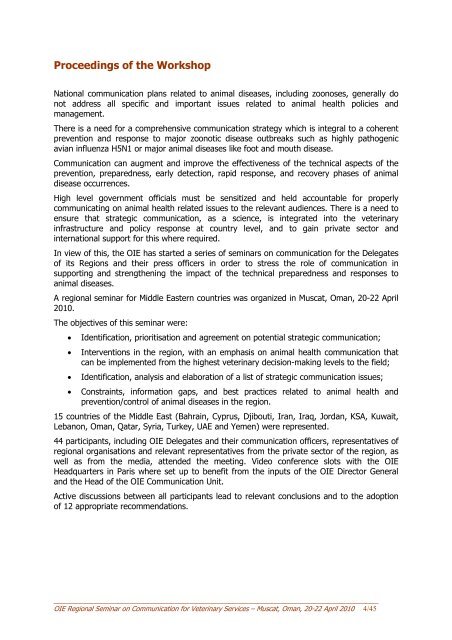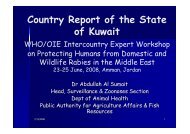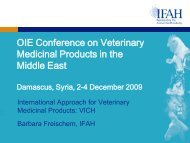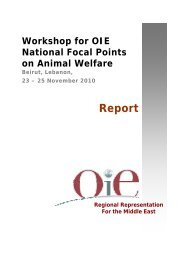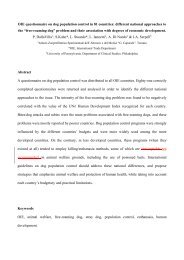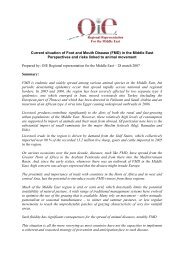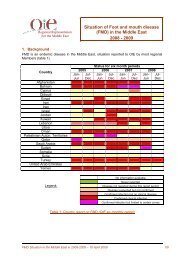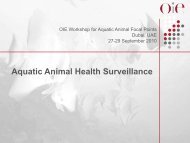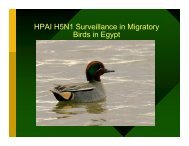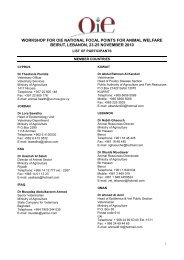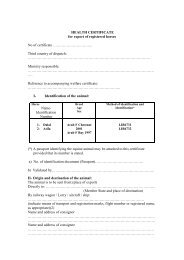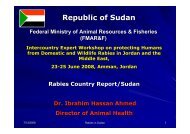Report - Middle East - OIE
Report - Middle East - OIE
Report - Middle East - OIE
You also want an ePaper? Increase the reach of your titles
YUMPU automatically turns print PDFs into web optimized ePapers that Google loves.
Proceedings of the Workshop<br />
National communication plans related to animal diseases, including zoonoses, generally do<br />
not address all specific and important issues related to animal health policies and<br />
management.<br />
There is a need for a comprehensive communication strategy which is integral to a coherent<br />
prevention and response to major zoonotic disease outbreaks such as highly pathogenic<br />
avian influenza H5N1 or major animal diseases like foot and mouth disease.<br />
Communication can augment and improve the effectiveness of the technical aspects of the<br />
prevention, preparedness, early detection, rapid response, and recovery phases of animal<br />
disease occurrences.<br />
High level government officials must be sensitized and held accountable for properly<br />
communicating on animal health related issues to the relevant audiences. There is a need to<br />
ensure that strategic communication, as a science, is integrated into the veterinary<br />
infrastructure and policy response at country level, and to gain private sector and<br />
international support for this where required.<br />
In view of this, the <strong>OIE</strong> has started a series of seminars on communication for the Delegates<br />
of its Regions and their press officers in order to stress the role of communication in<br />
supporting and strengthening the impact of the technical preparedness and responses to<br />
animal diseases.<br />
A regional seminar for <strong>Middle</strong> <strong>East</strong>ern countries was organized in Muscat, Oman, 20-22 April<br />
2010.<br />
The objectives of this seminar were:<br />
• Identification, prioritisation and agreement on potential strategic communication;<br />
• Interventions in the region, with an emphasis on animal health communication that<br />
can be implemented from the highest veterinary decision-making levels to the field;<br />
• Identification, analysis and elaboration of a list of strategic communication issues;<br />
• Constraints, information gaps, and best practices related to animal health and<br />
prevention/control of animal diseases in the region.<br />
15 countries of the <strong>Middle</strong> <strong>East</strong> (Bahrain, Cyprus, Djibouti, Iran, Iraq, Jordan, KSA, Kuwait,<br />
Lebanon, Oman, Qatar, Syria, Turkey, UAE and Yemen) were represented.<br />
44 participants, including <strong>OIE</strong> Delegates and their communication officers, representatives of<br />
regional organisations and relevant representatives from the private sector of the region, as<br />
well as from the media, attended the meeting. Video conference slots with the <strong>OIE</strong><br />
Headquarters in Paris where set up to benefit from the inputs of the <strong>OIE</strong> Director General<br />
and the Head of the <strong>OIE</strong> Communication Unit.<br />
Active discussions between all participants lead to relevant conclusions and to the adoption<br />
of 12 appropriate recommendations.<br />
_______________________________________________________________________________________<br />
<strong>OIE</strong> Regional Seminar on Communication for Veterinary Services – Muscat, Oman, 20-22 April 2010 4/45


